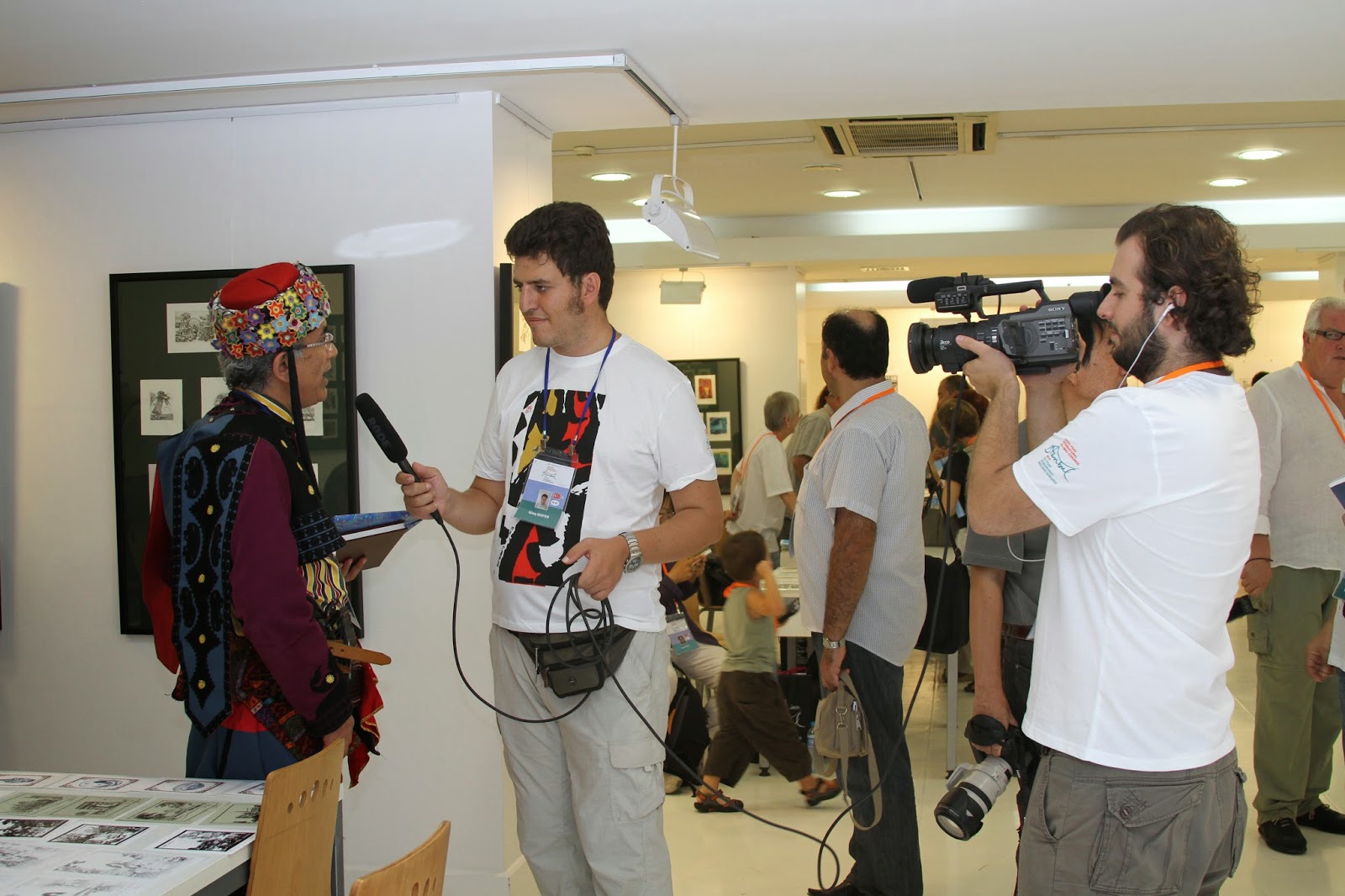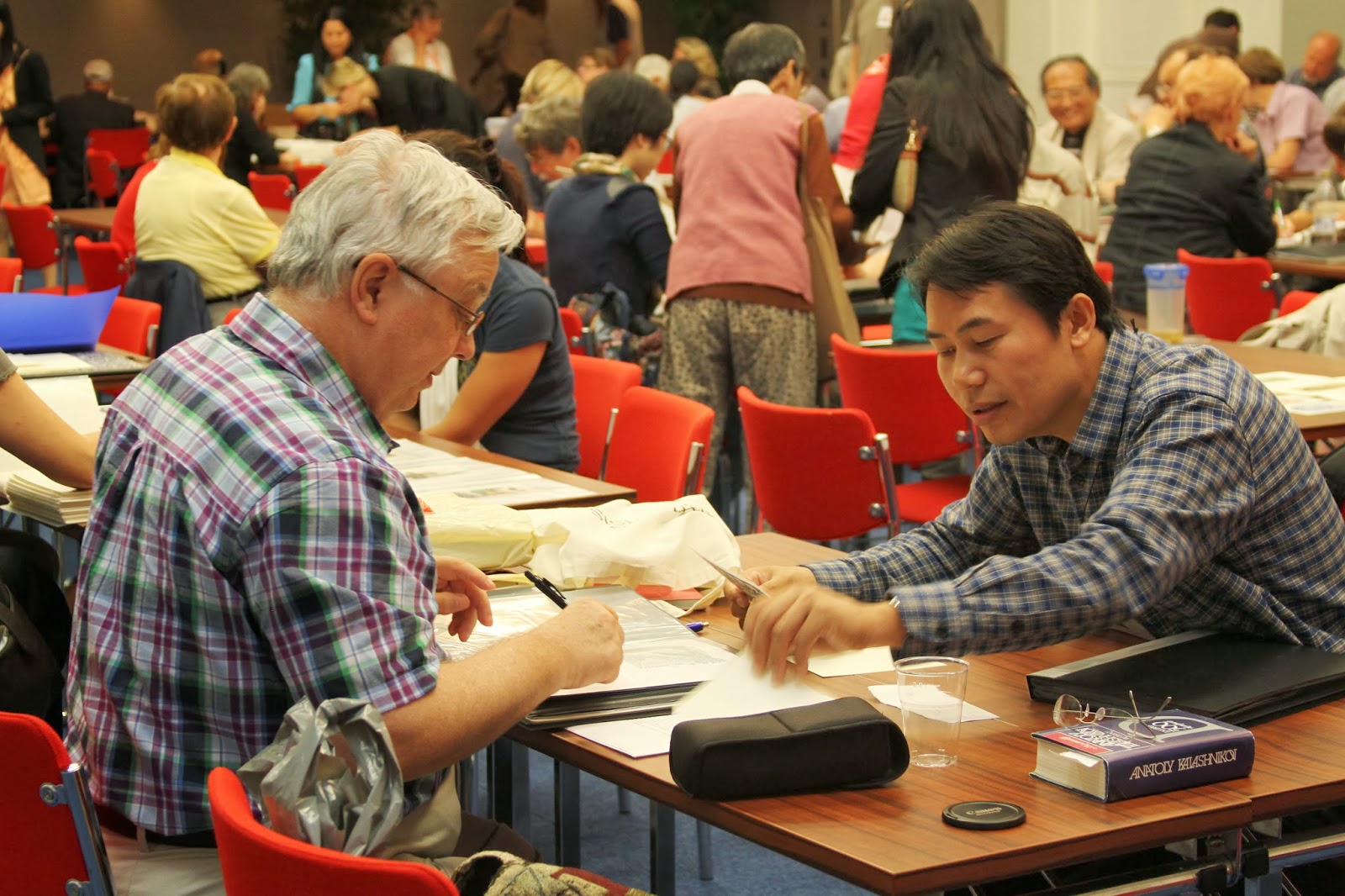Few collectors are more obsessed with detail than ex libris (bookplate) collectors or more inclined to sit in amiable silence with fellow enthusiasts to compare their collections and offer exchanges.


Their role in furthering international cooperation is little known. Yet, it is a remarkable fact that since the late nineteenth century, ex libris collectors have ignored cold wars, international tensions and military interventions in pursuit of their mutual respect and love of the ex libris, to meet at congresses, to talk, to compare and exchange ex libris. Yes, exchange, because even this aspect of their relations is unique and transcends the world and language of anything so pedestrian as money.
Notwithstanding these observations about bookplate congresses and exchanges, bookplate collections as a whole have been sold privately for sizable amounts of money, depending on the quality of the collection.
Who are the players in this great game of collecting? They are the designers, those who commission a design and the collectors (as well as dealers, auctions and exhibitions). Designers include both those working in traditional medium, such as wood engraving, and those applying more modern technology as used in computer generated ex libris.
For a fascinating discussion of the nature of a bookplate, how to form a bookplate collection, the history of bookplate collecting, and American bookplates in particular, you may wish to refer to William E. Butler's work
American Bookplates, offered for sale on the Primrose Hill Press website at
www.primrosehillpress.com.

What are bookplates? While this may seem to be a simple question, what constitutes a bookplate has always been the subject of rather heated debate among bookplate collectors and more so recently with the advent of computer generated bookplates as well as e-books. These developments have opened the door to so many interesting questions, in particular, questions that touch on the difference between what is known as an "ex libris" and a "bookplate" and the nature of a "book". For example, can an e-book contain a bookplate? Or does the very nature of a "bookplate" assume that the "book" must be in a physical form? In its barest essentials, a bookplate is a thing affixed to a book for the purpose of identifying the owner of the book. Traditionally, and most generally, a bookplate has been a paper on which is displayed the name of the owner of the book and which is usually affixed to the inside cover of a book or flyleaf. And herein is the difference, many argue, between an "ex libris" and a "bookplate". Recently, the International Federation of Ex Libris Societies ("FISAE") officially took the position that "ex libris" is a broader term which encompasses not only bookplates but also a manuscript autograph signature or an inscription which many write on the flyleaf, title page or inside cover of books which they own. For information on worldwide societies of bookplate collectors, you may wish to visit the FISAE website at
www.fisae.org
Whatever your personal view in this debate, it would be a great mistake to conclude that the essential nature of the bookplate or ex libris can be reduced to the modest function of attributing ownership. The reality is that it can be and often is so much more. An ex libris can be a magnificent work of art commissioned from one of the old masters (in particular wood engravers) by a wealthy and powerful historical figure (Peter the Great or George Washington), or it may be something more modest, personal and down to earth, perhaps nothing more than a brief, personal note from a friend or relative gifting a book and stating the ownership: "This book belongs to Mary Trouver given this 13th day of May 1845 on my dear niece's thirteenth birthday". An ex libris can be a clue to questions surrounding the provenance of a book, to solving mysteries surrounding what a historical figure may or may not have been aware of by virtue of his or her library, or the intellectual leanings of that person. Did Abraham Lincoln have an interest in Masonic Temples, and did this affect his world view? Did a Supreme Court Justice read that obscure treatise on point? Were the relevant books in their libraries and can you prove that by pointing to a book containing their ex libris? Or what about that wonderful, possibly rare, book you discovered in your attic? Might a bookplate (or bookplates in the case of successive ownership) reveal where that book has traveled? Or, as you nervously peek at the inside cover, will you instead see the lowly bookplate of your local library, a commercially produced eyesore?
The earliest known marks of ownership on books have been traced back to ancient China, India, Korea and Egypt The earliest printed bookplate originated in Germany circa 1450. In England the earliest bookplate is considered to be that of Sir Nicolas Bacon (1564). Book labels printed in English colonies originated circa 1642. Today, artists are routinely commissioned to design personal bookplates such that this practice is now quite widespread. With this popularity has come an unprecedented sophistication and specialization of the bookplate: Sherlockian bookplates, erotic bookplates, bookplates dedicated to cities or countries (American bookplates, British bookplates, London Bookplates) or to professions (legal bookplates).
You can find books with all of these themes on our website at
www.primrosehillpress.com. Bookplates today can be breathtakingly beautiful depictions or more cerebral or provocative social or political pictorial statements. There are simply no boundaries for bookplate design and collecting. If you are interested in engraving, in particular collecting wood engravings, you will find bookplates to be an amazing source of magnificent engravings. Our website offers a wide variety of books on engraving, both fine press books containing original wood engravings and commercial editions as well as several books on engravers. In particular you may be interested in the popular book by Simon Brett,
An Engraver's Globe. www.primrosehillpress.com.
How can you become involved in this madness? The bookplate has been called a "passport to friendship" among the international fraternity of bookplate collectors, a function far removed from the original modest purpose of using a bookplate to designate ownership. FISAE and other bookplate societies play a key role in these interactions. These societies often hold regular meetings or congresses where participants can meet other bookplate owners and collectors, designers (artists) and others interested in bookplates, acquire or exchange bookplates and participate in informative talks and lectures.



What is remarkable about many of these meetings (especially those of FISAE) is their international flavor. Conferences have been held in China, Russia, EU countries, the United States and elsewhere around the globe. Since not all participants speak a common language, you might expect some confusion during the exchange or purchase of bookplates, but you would be wrong to do so. With no translators and a handful of words commonly understood, participants negotiate, shake hands and agree transactions in a matter of minutes. New friendships are born, and you can be sure that the friendships will be revived at every future congress of this world fraternity of ex libris collectors. Come join us! (And for those FISAE members who have journeyed to this blog, if you would like to see many more photos from FISAE conferences, come find us on Facebook.)



For more information on FISAE and other bookplate societies, you can visit the FISAE website at
www.fisae.org. For more information on books we carry related to bookplates, be sure to visit
Primrose Hill Press!
 But legal translation in the context of Russian law is an inherently shifting comparative law exercise; it is organic. Any "code" (lexicon) to be applied to translating Russian legal texts must be based on an intimate understanding of Russian law on both an historical and comparative level to enable the translator to communicate the essential meaning and nuances of Russian legal terminology. Good translators must be able to adjust that "code" as Russian legal language continues its evolution. As William E. Butler reflects in a chapter dedicated to legal translation in Russian Law and Legal Institutions (London, Wildy, Simmonds & Hill, Publishers, 2014): "Possibly we are witnessing the third major revolution in Russian terminology: the first introduced by Peter the Great accompanied by the importation of European legal terminology; the second by the Great October Revolution of 1917 and the deliberate systemic sovietization of legal terminology; and third the absorption or invention of new terms and concepts associated with ... the market economy." But as Butler makes clear, Russian lawyers and legislators have not simply invented or imported concepts and terminology, but rather those concepts and terminology have a life of their own and are constantly evolving in the cauldron of legal relationships domestically and globally.
But legal translation in the context of Russian law is an inherently shifting comparative law exercise; it is organic. Any "code" (lexicon) to be applied to translating Russian legal texts must be based on an intimate understanding of Russian law on both an historical and comparative level to enable the translator to communicate the essential meaning and nuances of Russian legal terminology. Good translators must be able to adjust that "code" as Russian legal language continues its evolution. As William E. Butler reflects in a chapter dedicated to legal translation in Russian Law and Legal Institutions (London, Wildy, Simmonds & Hill, Publishers, 2014): "Possibly we are witnessing the third major revolution in Russian terminology: the first introduced by Peter the Great accompanied by the importation of European legal terminology; the second by the Great October Revolution of 1917 and the deliberate systemic sovietization of legal terminology; and third the absorption or invention of new terms and concepts associated with ... the market economy." But as Butler makes clear, Russian lawyers and legislators have not simply invented or imported concepts and terminology, but rather those concepts and terminology have a life of their own and are constantly evolving in the cauldron of legal relationships domestically and globally.



































